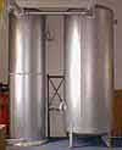Fog Signal Building
 Dense fog envelops the waters around Pigeon Point throughout the year. In 1871, prior to the lighthouse being lit on November 15, 1872, a locomotive steam whistle started blasting its warning to ships at sea. The original signal was fueled by cordwood and water. It required 45 minutes to produce enough pressure to sound the steam whistle. Every fog signal station sounded its own distinctive pattern so that captains could pin-point their position.
Dense fog envelops the waters around Pigeon Point throughout the year. In 1871, prior to the lighthouse being lit on November 15, 1872, a locomotive steam whistle started blasting its warning to ships at sea. The original signal was fueled by cordwood and water. It required 45 minutes to produce enough pressure to sound the steam whistle. Every fog signal station sounded its own distinctive pattern so that captains could pin-point their position.
This Fog Signal Building was used from the late 1890s to 1909. It housed the boilers needed for the fog signal to operate.
 Forty years later a more efficient, steam-powered siren was installed. This is the Fog Signal Building seen today at Pigeon Point. It was built in 1909.
Forty years later a more efficient, steam-powered siren was installed. This is the Fog Signal Building seen today at Pigeon Point. It was built in 1909.
Looking at the west side of the Fog Signal Building, you see the horns used by the 1909 diaphone fog signal. This system was heard up to five miles away.
 In 1933, a diesel-powered air-pressure diaphone was installed. It was heard over five miles. These are two of the three large pressure tanks installed by the Coast Guard to improve the performance of the Pigeon Point fog signal.
In 1933, a diesel-powered air-pressure diaphone was installed. It was heard over five miles. These are two of the three large pressure tanks installed by the Coast Guard to improve the performance of the Pigeon Point fog signal.
The foghorn was discontinued in 1976 when loran, radar and other electronic aids made sound signals obsolete.
